Origin of Earth’s Moon
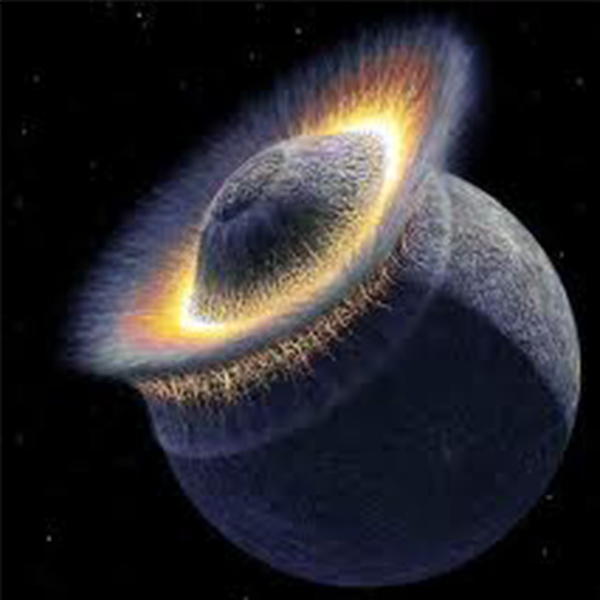
Artist image of Theia crashing into Earth (Memomiguel, Wikimedia Commons)

Artist image of Theia crashing into Earth (Memomiguel, Wikimedia Commons)
How does this align with my curriculum?
Learn how Earth’s moon came to be and what we have learned from Moon rocks.
“The more we learn about how the Moon came to be, the more we discover about the evolution of our own Earth,”
Vincent Eke (Researcher at Durham University)
In the decades since the first Moon landing, we have learned a lot about our closest neighbour in the solar system. But there are still many mysteries waiting to be solved. The clues that we have gathered so far tells us that the Moon probably formed soon after the Earth, around 4.5 billion years ago. Of course, there were no humans around to see this. So how do scientists think our Moon came to be?
How do we think the Moon formed?
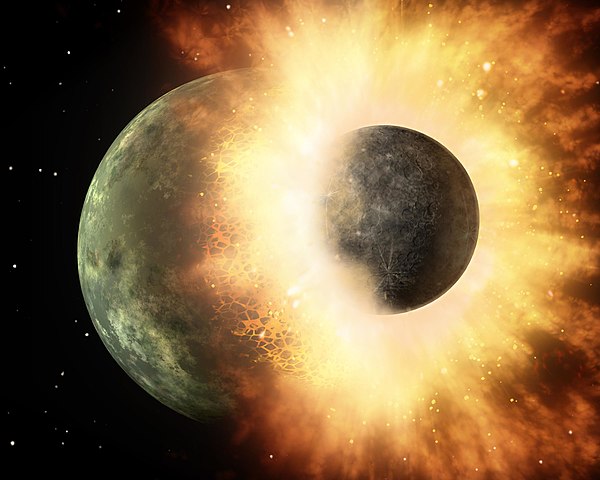
Image - Text Version
Shown is a colour illustration of a sphere crashing into a larger one, with a bright explosion.
The larger sphere looks like it has water and cloud cover. No distinct continents are visible. A smaller, darker sphere is crashing into the right side. The point of contact is surrounded by a bright orange explosion, larger than either object. Fragments and dust are spewing out in all directions. In the background is black space with white pinprick stars.
How exactly the Moon formed is still a puzzle to researchers. The latest simulations and theories suggest that the Moon may have formed in a matter of hours. Previously people thought that it may have taken millions of years. After Theia hit, material from both the Earth and Theia were thrown into orbit. Bits of both are then thought to have combined to form the Moon, our natural satellite.
This newly formed Moon was extremely hot. It was so hot that it was a thick liquid instead of a solid. Over time it began to cool and within about 100 million years, most of the “magma ocean” had cooled. As it cooled, rock that was less dense floated to the surface, eventually forming the lunar crust.
Why do we think it formed this way?
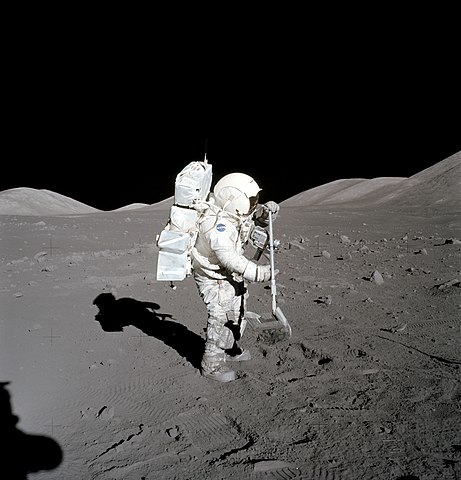
Image - Text Version
Shown is a black and white photograph of a person in a spacesuit, using a rake on grey, dusty ground.
The person is wearing a white suit, helmet and gloves with a large, white backpack. They are holding a white rake with both hands. Their shadow is sharp black on the fine, soft, grey soil behind. In the background, jagged rocks are sprinkled on the ground. There are low grey hills on the horizon, and deep black sky above.
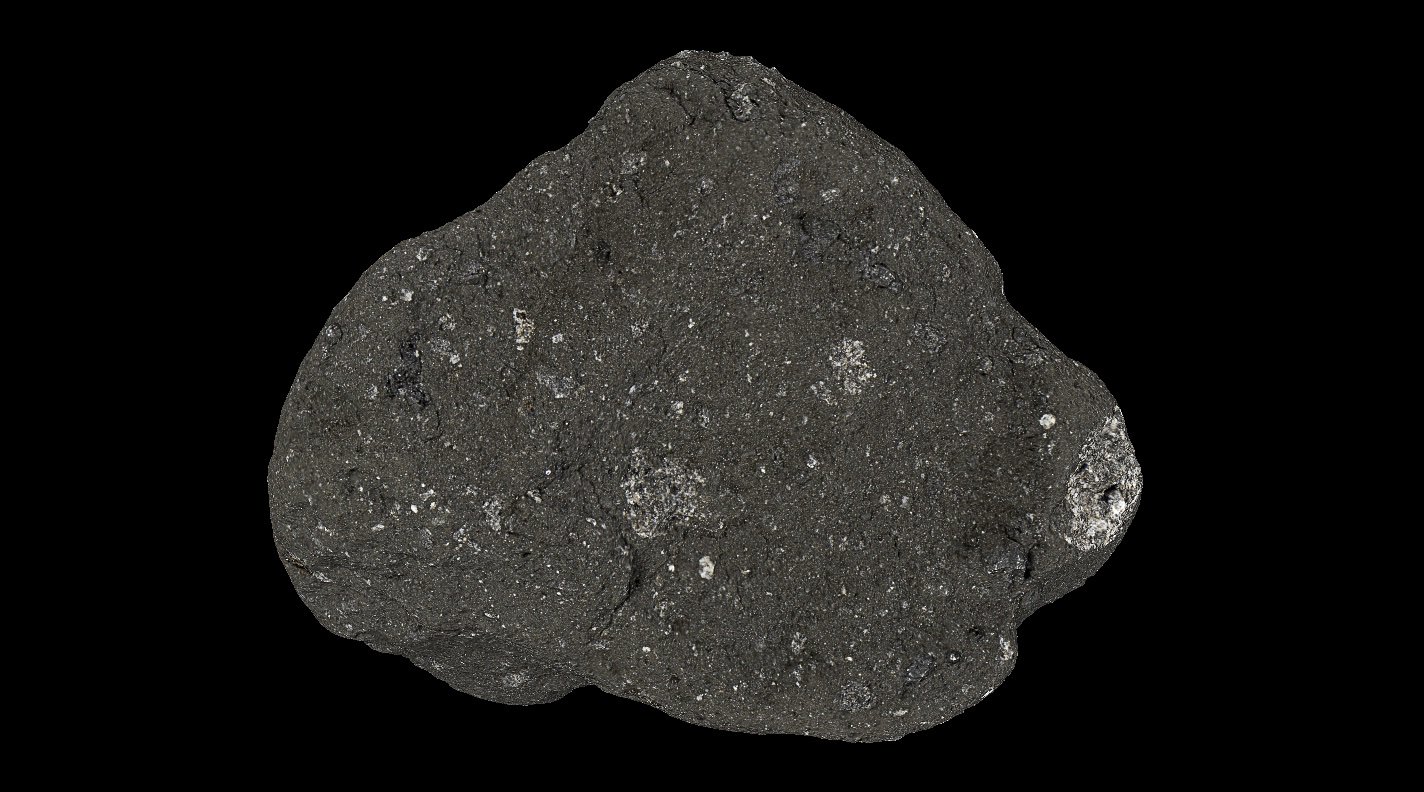
Image - Text Version
Shown is a black and white photograph of a dark grey rock with a rough, grainy texture.
The rock is an irregular, soft, round shape. It is dark grey and rough, with tiny flakes of light grey and white throughout. The background is plain black.
A Planetary Smackdown?
This led scientists to try to explain why the rocks are so similar. They came up with different variations of the Giant Impact Theory to try to line up with the evidence.
Scenario 1: Theia smashed Earth a little bit
In this scenario, after Theia hit Earth, it created a disc of debris around the Earth. This disc would have been like the rings of Saturn. The debris then eventually clumped together to form the Moon. If this happened, it would mean that the Moon was mostly made of Theia and not Earth. Since chemistry has proven that the rocks on the Moon and the Earth are very similar, it would mean that Theia had a chemical makeup very similar to Earth. Scientists say the chances of that are not very high.

Image - Text Version
Shown is a colour diagram of Theia hitting Earth and creating a ring of debris that becomes the Moon.
The image shows Earth at four different stages, from left to right.
In the first illustration, a small grey sphere, labelled "Theia", is moving toward a large blue sphere, labelled "Earth". A wispy tail behind Theia indicates it is moving quickly.
Next, the grey sphere contacts the top left part of the blue one, creating an explosion. This is labelled "Impact."
Next, the blue sphere is surrounded by a light grey ring, with darker grey particles floating in it. This is labelled "Disk of debris."
Finally, the grey sphere is labelled "Moon." It is above and to the left of the larger blue one, labelled "Earth."
Scenario 2: Several things hit the Earth
In this scenario, several smaller objects collide with the Earth one after the other. Each impact results in a disc of debris around the Earth like in scenario 1. Each of these smaller discs forms a tiny moon we call a moonlet. Over time, the moonlets eventually join together to form the single Moon we have today. This scenario has similar problems to scenario 1. Instead of having material similar to Earth, the Moon would have materials similar to the objects that created it. These would not likely have materials similar to Earth.
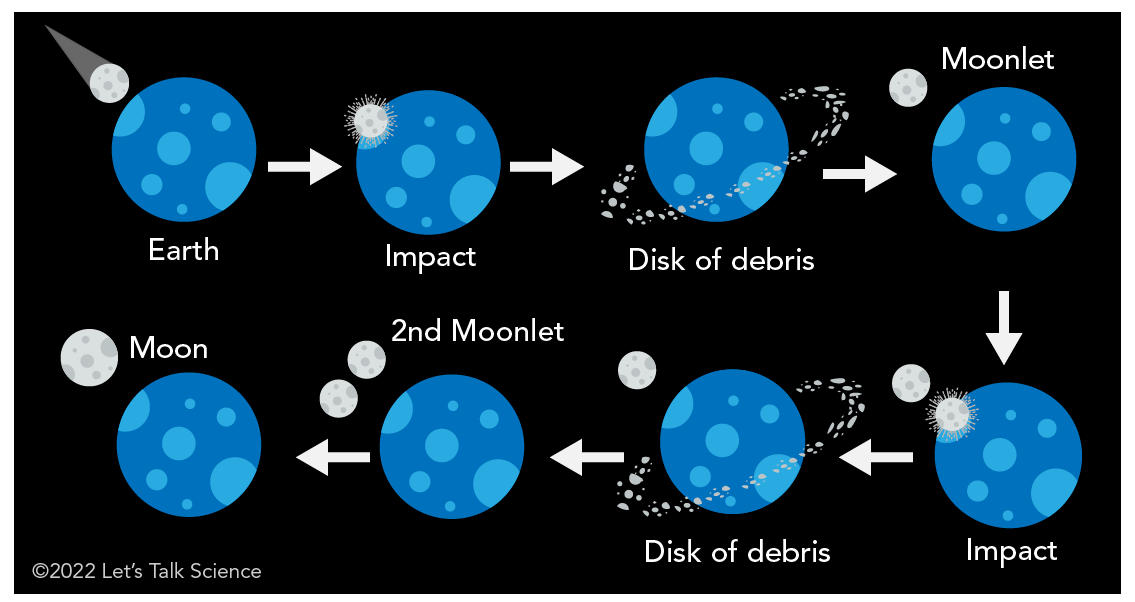
Image - Text Version
Shown is a colour diagram of two different objects hitting Earth and disks of debris that eventually become the Moon.
The image shows Earth at eight different stages, clockwise around the image.
In the first illustration, a small grey sphere is moving toward a large blue sphere, labelled "Earth".
Second, the grey sphere contacts the top left part of the blue one, creating an explosion. This is labelled "Impact."
Third, the blue sphere is surrounded by a ring of grey particles. This is labelled "Disk of debris."
Fourth, a small grey sphere is above and to the left of the larger blue one. This is labelled "Moonlet."
Fifth, a second, small grey sphere contacts the top left part of the blue one, creating an explosion.
Sixth, the blue sphere is surrounded by a ring of grey particles. The first grey sphere is still above and to the left. This is also labelled "Disk of debris."
Seventh, two small grey spheres are above and to the left of the large blue one. One of the grey spheres is labelled "2nd Moonlet."
Finally, one slightly larger grey sphere is above and to the left of the blue one. This is labelled "Moon."
Scenario 3: Theia smashed Earth a lot!
In this scenario, after Theia hit Earth, both were blown apart. This would have let bits from each mix together. Over time, the bits would have come together in a rotating, donut-shaped cloud of hot materials. Scientists call this structure a synestia. Eventually, the center of the cloud cooled to form the Earth. The outer parts would have formed the Moon. This scenario lines up with the evidence that both Earth and the Moon have similar rocks.

Image - Text Version
Shown is a colour illustration showing a small grey sphere and a larger blue sphere crashing with a large explosion, forming a donut-shaped cloud, then Earth and the Moon.
The image shows Earth and Theia at four different stages, on a black background, joined together with white arrows, from left to right.
In the first illustration, a small grey sphere, labelled "Theia," is moving toward a large blue sphere, labelled "Earth".
Second, both spheres explode, spewing blue and grey particles in every direction. This is labelled "Impact."
The third illustration is a pale bluish grey, donut-shaped object. This is labelled "Synestia."
In the final illustration, a small sphere, labelled "Moon," is above and to the left of the larger one., labelled "Earth." Both spheres are blue and sprinkled with large grey blobs.
To get a sense of which of these scenarios is the most correct, scientists would need more rock samples. They should be able to get some from the Artemis missions. These missions plan to get humans back to the Moon.
What types of rocks and minerals can we find on the moon?
From 1969 to 1972, six Apollo missions brought back 382 kilograms of rocks and soil from the Moon. These rock samples have helped us learn a lot about the Moon and our Solar System.
Did you know?
New tools on Earth have allowed researchers to examine the Apollo samples in greater depth. Many of these samples are still in pristine condition.
Unlike the Earth, the Moon has no atmosphere. This means that there is nothing to keep asteroids, meteoroids, and comets from hitting its surface. Over the billions of years that the Moon has existed, these objects have pounded the Moon’s surface. Some of the Moon’s rocks are still large, but others have been crushed into a fine powder!
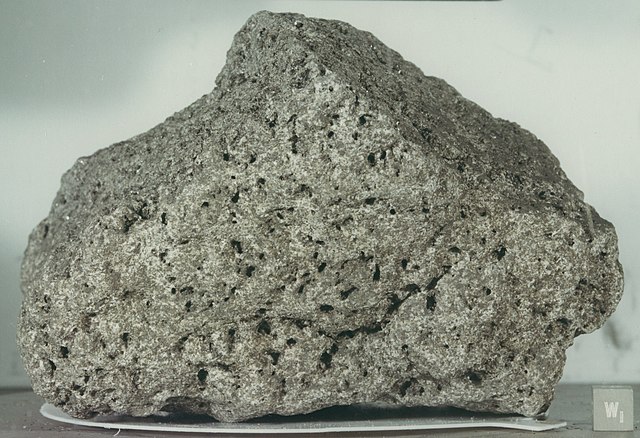
Image - Text Version
Shown is a colour photograph of pale greyish beige rock with a dimpled texture.
The rock has irregular, flat sides with rounded edges and corners. It is grainy, greyish beige, sprinkled with tiny dimpled holes. The texture is similar to a natural sponge.
It is sitting on a white mat, on a grey table, with a pale grey background.

Image - Text Version
Shown is a colour photograph of a pale grey rock on a stand in a dark museum case.
The rock has a rough texture and a surface of low, rounded mounds. It is pale grey and lit with a strong light from above. In the background, the clear sides of a museum case are visible, as is the darkened room beyond.
Did you know?
Lunar basalts are found in the flat dark plains of the Moon. We call these plains the lunar maria. The word “maria” is Latin for seas. Lunar anorthosites are found in brighter lunar highlands. We call these highlands the lunar terrae. The word “terrae” is Latin for land.
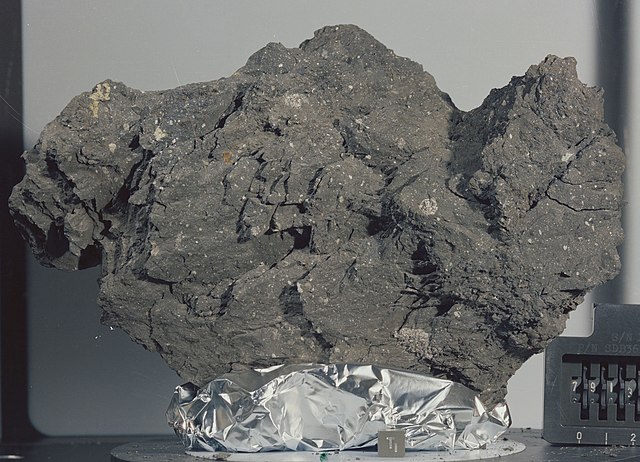
Image - Text Version
Shown is a colour photograph of a grainy, jagged, dark grey rock, sitting on silver foil.
The rock is a jagged oval shape, with sharp, brittle-looking edges and corners. The texture is rough and grainy, mostly grey with bits of light beige sprinkled throughout.
At the base of the rock is some bunched up silver foil. This looks like it is holding it upright on a smooth grey table.
In the bottom right corner of the photograph is a grey box, on the table. It has several small levers on the front, each printed with a white number. Another row of numbers is printed across the bottom of the box itself. No explanation is given for this object.
Did you know?
A new mineral was discovered in rocks collected by Apollo 11 astronauts. They named it armalcolite, which is a word made from the first letters of the astronauts’ surnames—Armstrong, Aldrin, and Collins.
Is there water on the Moon?
For a long time, people had wondered if there was water on the Moon. In the late 1990s, scientists using the orbiting spacecraft Lunar Prospector found large amounts of hydrogen at the Moon’s north and south poles. Hydrogen is a key part of water molecules (H2O). Could this mean that there was water on the Moon?

Image - Text Version
Shown are two black and white photographs of the Moon's poles, sprinkled with bright green areas to indicate ice.
Each photograph is round, on a white background. Lines of latitude and longitude are marked on each one. The longitude lines cross in the centre of each one, indicating these are the poles. In both, the moon is grey and marked with rough, round indentations of various sizes.
On the left, the bright green areas are dense around and above the pole. The green appears mostly in the round indentations of the craters. A few tiny green points are sprinkled further away from the pole, especially in the dark, shadowed areas.
On the right, the green areas are much smaller, and fewer. They are sprinkled in the shadowed walls of the craters, and other dark areas.
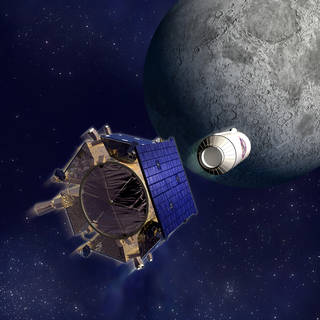
Image - Text Version
Shown is a colour illustration of a hexagonal blue object and a cylindrical white object above the Moon.
The object in the foreground is gold coloured inside, and appears hollow. It is surrounded by six blue solar panels that form a hexagonal shell. In front of it is a white, cylindrical object with a round opening at the closest end.
Both objects have faint, wispy tails behind them, and appear to be moving along the same path, toward the Moon in the background.
The moon takes up most of the top right section of the image. It is grey with visible craters. The background is dark blue space with tiny stars.
After these discoveries, scientists were confident that there was ice in craters at the Moon’s poles. But what about on the rest of the Moon in the sunlit parts?
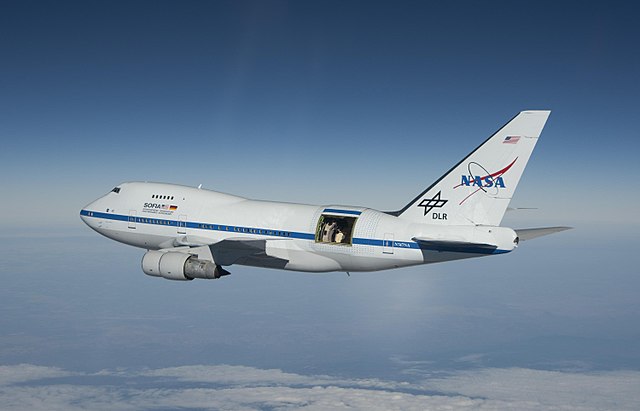
Image - Text Version
Shown is a colour photograph of a plane in flight, with a large open door.
The plane is shown high above a snowcapped mountain range. The sky behind goes from light blue, near the mountains, to dark blue at the top of the image.
The plane is a large white airliner. It has the NASA logo, and another logo on the tail. A large, square opening has been cut into the side of the body, near the back.
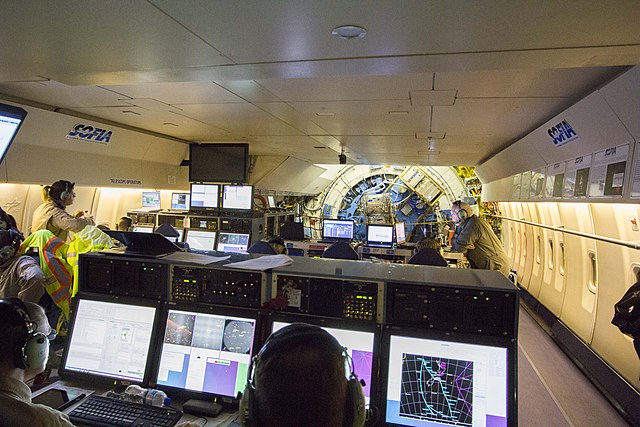
Image - Text Version
Shown is a colour photograph of the inside of an airliner where the seats are replaced with workstations and computer monitors.
All the seats have been removed from the airplane cabin. People in earphones and headsets are shown working at several rows of computers and control boards that take up the space.
At the far end of the cabin, a blue, circular machine is built into the wall.
Is There Water on the Moon? We Asked a NASA Scientist (2022) NASA (1:39)
Did you know?
The Sahara desert has 100 times more water than SOFIA found on the Moon.
How did water get on the Moon?
Scientists have suggested 3 ways water could have formed on the Moon:
- Water exists because of how the Moon was formed (Giant Impact Theory).
- Water came to the Moon from asteroids or comets.
- Water was created on the Moon by solar winds combining oxygen and hydrogen.
So far, the best theory for the formation of the moon is that the Moon is made partly of Earth and the protoplanet Theia. So, the Moon’s water may have originally come from the Earth.
Why care about water on the Moon?
For long term human settlement on the Moon, people will need water. Since it costs between $10 000 - $20 000 to launch a kilogram of anything from the Earth to space, it would be ideal if the water people needed was already on the Moon itself. This is the reason why part of the upcoming Artemis missions is to search for good sources of water. Canada is playing an important role in the search for water. You can read more about the rover Canada is sending and the challenges it will face looking for water on the Moon in this backgrounder.
Learn More
Objective Moon - Learn About the Moon
A collection of Moon-related resources by the Canadian Space Agency CSA. Get all the interesting facts and have your questions answered.
Moon 101
A video from National Geographic to help you learn about the Moon's violent origins, how its phases shaped the earliest calendars, and how humans first explored Earth's only natural satellite half a century ago.
NASA Astromaterials 3D
Check out high resolution 3D images of Moon rocks collected during various Apollo missions.
Where did the Moon come from? A new theory | Sarah T. Stewart
In this TED-Ed video, learn how Sarh Stewart, a planetary scientist, tests theories about the origin of the Moon.
References
Boyle, R. (Aug 2, 2017). What Made the Moon? New Ideas Try to Rescue a Troubled Theory. Quanta.
Britannica (n.d.) Moon - Lunar Exploration Origin and Evolution of the Moon.
Colaprete, A., P. Schulz, J. Heldmann, et al (2010). Detection of Water in the LCROSS Ejecta Plume. Science 330(6003): 463-
Canadian Space Agency CSA (n.d.) One Moon Among Many (For Educators).
Crockett, C. (2019, July 16) How Moon Landings Changed our View of our Solar System. Knowledgeable Magazine.
Wikipedia (n.d.). Geology of the Moon.
Jones, A., Barry, C., Vogel, T. (n.d.) Overview: Inside and Out. NASA Science Earth’s Moon.
Lutz, D. (2016, Sept. 12) Chemistry says moon is proto-Earth’s mantle, relocated. Washington University in St. Louis.
NASA Science (2021, Sept. 21) Evolution of the Moon from NASA’s Lunar Reconnaissance Orbiter.
NASA (2019, Mar 8) What is LCROSS, the Lunar Crater Observation and Sensing Satellite?
PBS Learning Media (2019, July 12) Unanswered Questions - Moon Formation and the Earth.
Potter, S. (2020, Oct. 26) NASA’s SOFIA Discovers Water on Sunlit Surface of Moon. NASA.
Tabor, A. (2018, Aug. 20) Ice Confirmed at Moon’s Poles. NASA
Tavares, F. (2022, Oct. 4) Collision May Have Formed the Moon in Mere Hours, Simulations Reveal. NASA.